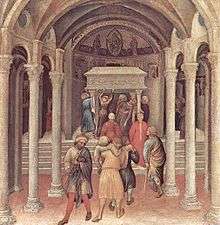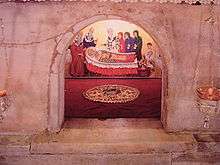Basilica di San Nicola
| Basilica of Saint Nicholas Basilica di San Nicola | |
|---|---|
 The Basilica di San Nicola by night. | |
| Basic information | |
| Location | Bari, Italy |
| Geographic coordinates | 41°7′48.94″N 16°52′13.01″E / 41.1302611°N 16.8702806°ECoordinates: 41°7′48.94″N 16°52′13.01″E / 41.1302611°N 16.8702806°E |
| Affiliation | Roman Catholic Church |
| Province | Archdiocese of Bari-Bitonto |
| Country | Italy |
| Year consecrated | 1197 |
| Ecclesiastical or organizational status | Minor basilica |
| Status | Active |
| Architectural description | |
| Architectural type | Church |
| Architectural style | Romanesque |
| Groundbreaking | 1089 |
| Completed | 1197 |

The Pontifical Basilica di San Nicola (Basilica of Saint Nicholas) is a church in Bari, southern Italy that holds wide religious significance throughout Europe and the Christian world. The basilica is an important pilgrimage destination both for Roman Catholics and Orthodox Christians from Eastern Europe.
History
The basilica was built between 1087 and 1197, during the Italo-Norman domination of Apulia, the area previously occupied by the Byzantine Catapan of which Bari was the seat. Its foundation is related to the recovery of some of the relics of Saint Nicholas from the saint’s original shrine in Myra, in what is now Turkey. When Myra passed into the hands of the Saracens, some saw it as an opportunity to move the saint's relics to a safer location. According to the justifying legend, the saint, passing by the city on his way to Rome, had chosen Bari as his burial place. There was great competition for the relics between Venice and Bari. The latter won, the relics were carried off under the noses of the lawful Greek custodians and their Muslim masters, and on May 9, 1087, were safely landed at Bari. A new church was built to shelter Nicholas' remains and Pope Urban II was present at the consecration of the crypt in 1089. The edifice was officially consecrated in 1197, in the presence of the Imperial Vicar, Bishop Conrad of Hildesheim, and of numerous bishops, prelates and noblemen. Elias, abbot of the nearby monastery of Saint Benedict, was named as first archbishop. His cathedra (bishop's throne) still stands in the church to this day.
Architecture

The church has a rather square appearance, seemingly more suited to a castle than to a church. This impression is strengthened by the presence of two low massive towers framing the façade. It was indeed used several times as castle during its history.
The interior has a nave and two aisles, divided by granite columns and pilasters. The presbytery is separated from the rest of the edifice by mean of three arches supported by columns of Byzantine influence. Above the aisles is the matronaeum, a tribune gallery for women, opening into the nave. The basilica was the first church of this design, setting a precedent which was later imitated in numerous other constructions in the region.
Treasures

The Basilica houses one of the most noteworthy Romanesque sculptural works of southern Italy, a cathedra (bishop's throne) finished in the late eleventh century for Elias. There are precious mosaic pavements in the crypt and presbytery. The ciborium, the most ancient in the region, is also decorated with mosaic; it has four columns with foliage, animals and mythological figures. The crypt, with 26 columns sporting capitals in Byzantine and Romanesque style, houses the relics of Saint Nicholas.

In the church is the Renaissance tomb of Bona Sforza, (sixteenth century), in marble. The museum of the Basilica has precious works of art, including a collection of twelfth-century candlesticks donated by King Charles I of Anjou.
The church was restored in the late thirteenth century, in 1456 and in the seventeenth century. In the twentieth-century restoration, most of the Baroque additions were removed, leaving only the gilded wooden ceiling, enframing canvases by Carlo De Rosa.
Feast days
December 6 is Saint Nicholas Day, the main feast day of Saint Nicholas. On this day, it is traditional for the clergy of the basilica to lower a flask into the subterranean tomb of Saint Nicholas to extract some of the myrrh which is believed to exude from the relics. Containers of this myrrh are sent all over the world, and believers have reported numerous miracles as a result of being anointed with it. For those Orthodox Churches which follow the traditional Julian Calendar, December 6 falls on December 19 of the Gregorian Calendar, so there will actually be two celebrations of the same holy day: one according to the New Calendar (December 6) and one according to the Old Calendar (December 19). Both are celebrated with great solemnity at Bari.
May 9 (May 22) is celebrated annually in the Russian Orthodox Church as the feast day of the "Translation of the Relics of Saint Nicholas from Myra to Bari".
Pilgrimages to the basilica from Eastern Europe have increased dramatically since the fall of the Iron Curtain, not only for the feast days, but throughout the year.
See also
- Main sights in Bari
- Saint Nicholas
- Cathedral of Acquaviva delle Fonti
- Cathedral of Altamura
- Sanctuary of Monte Sant'Angelo